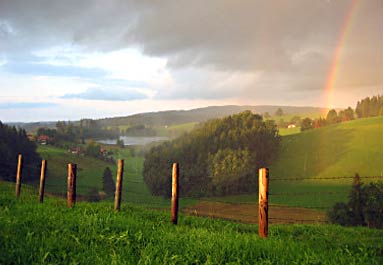This original column is provided free for one-time use with author credit at the end. It may be used for background with author credit. Copyright applies.
#68 FOR IMMEDIATE RELEASE: January 8, 2009
Is 2009 the time to buy a second home?
By Curtis Seltzer
BLUE GRASS, Va.—Second homes in America have become as American as apple pie. A beach house, small farm, spot on a lake, condo in a recreation destination—some nine million of us own such places.
A National Association of Realtors’ (NAR) survey indicated that about 740,000, or about 12 percent, of all existing- and new-home sales in 2007 were vacation homes. That was down about 31 percent from 2006 sales of 1.067 million vacation properties. The Realtors’ 2008 survey will be available in early April at www.realtors.org.
Despite a 31 percent decline in sales, the 2007 NAR data also showed that the median sales price of vacation homes from 2006 to 2007 dropped only 2.5 percent, to $195,000. In the first part of this Recession, vacation homes held their market value even though sales fell by almost one-third in one year.
Almost half of the vacation homes NAR surveyed were in small towns (17 percent) and rural areas (30 percent).
Anecdotal evidence suggests that vacation-home sales continued to fall at a faster rate in 2008 than their prices.
Vacation-home prices have also held up better than metropolitan housing, which dropped 20 percent in the 20 largest metropolitan areas tracked by the S&P/Case-Shiller composite house price index in the 18 months following a mid-2006 high.
In addition to second homes, rural areas are a market for owner-occupied housing. Resident homeowners are both born-heres and come-heres, such as retirement relocators.
Prices for rural, owner-occupied houses have risen slightly more than two percent since early 2007, according to data gathered by the Office for Federal Housing Enterprise Oversight (OFHEO) and cited in a recent report from the Federal Reserve Bank of Kansas City. Non-metro (rural) housing prices ran counter to price declines in metro areas.
Why have second homes and owner-occupied rural housing proved more price-stable than metro housing during the last two years? Several reasons come to mind.
First, as the Kansas City Fed points out, lending practices in rural areas did not follow the now-troubled, bail-out banks into no-doc loans, 100 percent financing, foreclosure-guaranteeing ARMs, subprime predatory lending and the rest of it. Second, rural economies that depended on agriculture and energy have so far been hit less hard than urban manufacturing centers and once go-go residential markets like Phoenix and Orlando. Third, rural housing prices were not artificially inflated by speculators or panic-driven buyers who feared that they had to buy before they were left behind.
But the last quarter of 2008 and 2009’s first six months will probably show price weakening in vacation homes and rural owner-occupied housing. Inventory of unsold property has piled up, and all-collar unemployment is squeezing everyone’s ability to carry a mortgage. The market will force prices lower to find buyers as this Recession roosts on our heads like a catatonic hen.
In circumstances like these, as ugly as it sounds, buyers of second homes and other rural property will nose around for opportunities amid the distress. Where might value be found?
Search in second- and third-tier recreation areas. If you’re cost conscious, you might want to avoid high-priced recreation destinations and steroidal resorts. The best buys may still not have shaken out in the most popular second-home communities such as Asheville, North Carolina, Park City, Utah, Ashland Oregon and Myrtle Beach, South Carolina—all of which were top-ten, second-home destinations in recent years.
The best buys will be in nice places that have yet to be turned into trendy destinations. Look for small towns that are still about one-third pickup trucks and have no yak-butter crepe place.
Look for the hot spots of pain. Some second-home communities that saw the highest price appreciation rates since 2002 are likely to be corrected the hardest. Not every over-priced property will be knocked down, but a few will. Look for the newly fallen apple, not the one that’s lashed on the topmost branch with steel cable.
A lot of nice country surrounds the Rust Belt—along the northern tier of states from the East Coast into the Midwest. The automotive and metal industries that built this belt are downsizing, if not disappearing. Second homes and recreation properties that their wage and salary employees bought in the good times are coming on the market.
Think two-steps: land first, housing later. Bargain hunters with limited cash should focus on unimproved land. Make-shift housing can be arranged until money to build becomes available. Used campers are a relatively cheap first housing choice on recreation tracts. Modular housing provides good value, fast construction and many custom options.
Think smaller. Families can adapt to a smaller second-home footprint using temporary housing when needed. An extra $100,000 might buy you more bedrooms that you use twice a year, for three days each time. A budget-conscious buyer would be far ahead to pack guest kids in a four-bunk camper for $3,500 and make reservations for their parents at the closest B&B.
Smaller second homes will also be cheaper to maintain and more energy efficient in any small-apple to big-apple comparison.
Think lower offer. I take no pleasure in suggesting that buyers should peg their offers to values of five to seven years ago. But the unavoidable fact is that sellers would not be marketing a second home right now unless they had to sell—right now. The valuations of 18 months ago -- asking prices -- are too high by ten to 50 percent.
A nice 100-acre-plus, lake-front property in Michigan had been priced at $6,000 an acre before it dropped this week to $4,000. This seller has had to face reality. Is $300,000 the likely sales price?
Look for farms whose owners have been wrung out of agriculture as they’ve practiced it. I hate writing that sentence, because I hate seeing farmers fail. But facts in the field don’t lie. Family dairy farms from New York through the upper Midwest are being sold, because of sector economics and the fact that it’s a very hard way to make a living. These farms are usually pretty and well-tended.
Look for timberland. Prices for standing timber -- called stumpage -- have fallen in some places and not in others. In the Southeast, for example, prices for hardwood sawlogs used for furniture and flooring have remained steady, because second-home and recreational owners of timberland are reluctant to cut their trees, thus restricting supply and maintaining stumpage prices. In West Virginia, Pennsylvania and New York, however, stumpage prices for hardwood sawlogs have fallen, in some species by as much as 50 percent over the last couple of years.
Where stumpage prices have fallen, the asking price and value of timberland should be discounted. Stumpage prices will improve when housing does.
Some timberland will be priced attractively, and in other cases, a buyer will be facing a no-budge seller. Buyers should look for tracts where at least 50 percent of the purchase price can be covered by the sale of the mature timber. Hold for a year or two before cutting, and then catch the upswing in timber prices.
Think of your second home as an income-generating investment, not just as a personal residence. The NAR reported in 2007 that 84 percent of second-home buyers said they bought a second home for vacations or as a family retreat; only 25 percent said they bought to rent to others.
Setting up a second home as a rental property generates income and brings tax benefits. Start with IRS 527, Residential Rental Property and IRS 936, Home Mortgage Interest Deduction. Several books are also available.
Before buying a second home with the intention of renting it, discuss the IRS rules with your accountant and follow that plan.
2009 is likely to be a hard year in many ways. But picky buyers may find a gem in the dross. From a seller’s perspective, priced right is half sold; from a buyer’s, bought right is half the profit.
Contact: Curtis Seltzer, Ph.D.
Land Consultant
1467 Wimer Mountain Road
Blue Grass, VA 24413-2307
540-474-3297
curtisseltzer@htcnet.org
www.curtis-seltzer.com
This original column is provided free for one-time use with author credit at the end. It may be used for background with author credit. Copyright applies.
|









